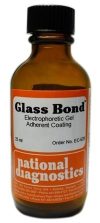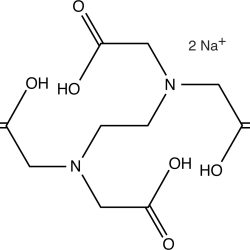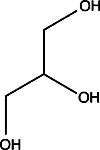Electrophoresis
Glass Bond
$108.00
- Chemically bonds the gel to the glass plate
- Prevents cracking and tearing of the gel
Description
- Chemically bonds the gel to the glass plate
- Prevents cracking and tearing of the gel
National Diagnostics’ Glass Bond allows polyacrylamide gels to be affixed to one of the glass plates used for casting electrophoresis gels. The glass plate is chemically modified so the gel becomes covalently bound to the glass, enabling it to be manipulated without danger of the gel ripping or slipping off the plate. Glass Bond is especially convenient for treating large sequencing plates, as subsequent manipulation can be performed without fear of ripping or disrupting the gel. On plates treated with Glass Bond, the gels dry down to a smooth plastic film without using a gel dryer, allowing autoradiography to be performed more easily. A total of 6.25 liters of bonding solution (enough for over 100 applications on 40 X 40 cm glass plates) can be made from one 25 ml bottle of Glass Bond.
Storage: Glass Bond is best stored tightly capped in a cool dry area.
Additional information
| Weight | .3 lbs |
|---|---|
| Dimensions | 6 × 3 × 3 in |
Protocol
Glass Bond Method of Uses
WARNING: Always work with Glass Bond in a hood.
- Ensure plates are clean and dry before starting the bonding procedure. If not clean, soak in 20% sodium hydroxide.
- Prepared enough bonding solution to fully submerge all the plates to be treated. Adjust the pH of 500 mL water by adding about 50µl glacial acetic acid. Add 20 mL Glass Bond and mixe well with magnetic stirrer until liquid dissolves.
- Pour Glass Bond solution into vessel containing the clean plates. Move plates to release trapped air bubbles. Incubate for 1-3 hours.
- Remove plates from vessel and rinse with distilled water. Allow plates to air dry then wipe clean
- Store plates interleaved between sheets of dry paper in plastic storage bag. Note: Acrylamide gels denatured with urea will crack upon drying unless fixed in 10% acetic acid/10% methanol solution for 30 minutes.
- If gels must be removed intact from the plate submerge the plate with the gel in water and carefully run a razor between them. For gels dried on the glass surface, rehydrate the gel by soaking in distilled water for 2-3 hours before attempting to detach.
Safety Overview
Safety Summary (see SDS for complete information before using product):
Appearance and Odor:
Clear colorless solution with acrid odor.
Irritating to eyes, respiratory system and skin.
In case of contact with eyes, rinse immediately with plenty of water and seek medical advice. After contact with skin, wash immediately with plenty of water.
EMERGENCY OVERVIEW – IMMEDIATE HAZARD
IRRITATING TO EYES, RESPIRATORY SYSTEM, AND SKIN. AVOID HEAT, FLAMES AND SPARKS.




